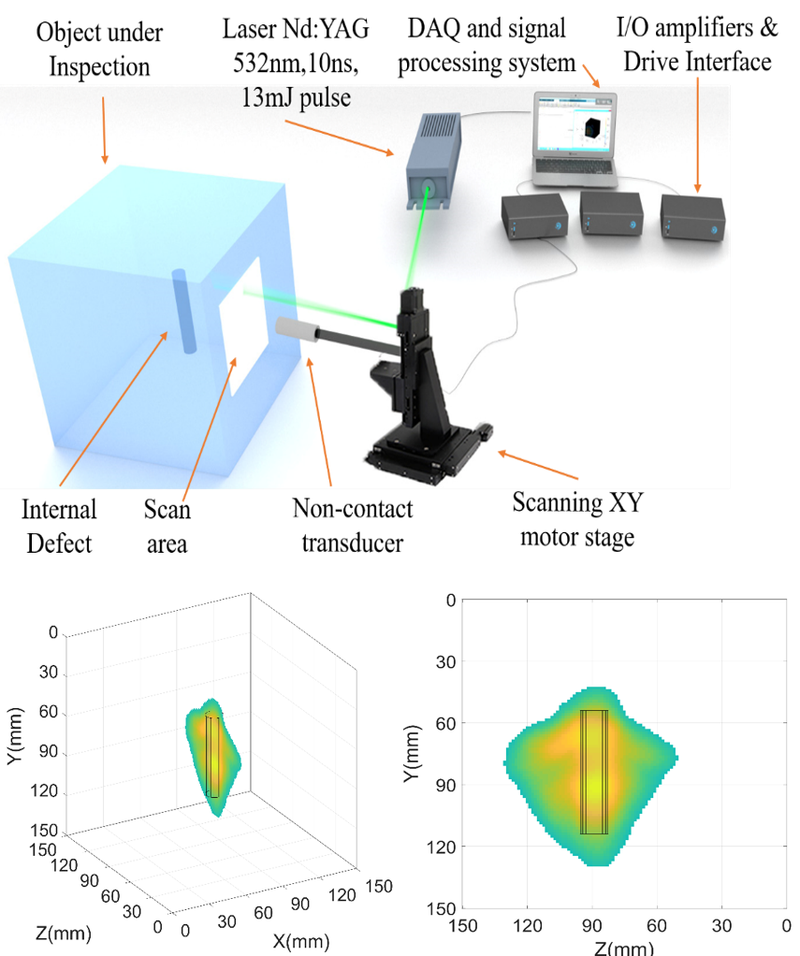Hossameldin Mohamed Selim Mohamed Selim presents his thesis on 3D reconstruction of defects using a non-destructive testing method based on laser-induced ultrasound
Jul 24, 2020
Hossameldin will present his thesis co-directed by Crina Cojocaru (Dept. of Physics) and Miguel Delgado prieto (Dept. of Electronic Engineering), on July 21 at the Terrassa Campus. Entitled "Hybrid non-destructive technique for volumetric defect analysis and reconstruction by remote laser induced ultrasound", the thesis is on the design, study and implementation of a non-destructive non-destructive testing (NDT) method. for the analysis of metallic objects containing internal defects or fractures. An opto-acoustic hybrid technique is proposed that combines ultrasound generated by laser impact as an exciter and ultrasound transducers as receivers.
This PhD thesis is devoted to the design, development and implementation of a non-contact hybrid non-destructive testing (NDT) method applied to the analysis of metallic objects that contain embedded defects or fractures. We propose a hybrid opto-acoustic technique that combines laser generated ultrasound as exciter and ultrasound transducers as receivers. This work envisages a detailed study of the detection and one, two or three-dimensional reconstruction of defects, using the proposed hybrid technique and its application as a remotely controlled non-contact NDT. Our device combines several advantages of both photonic and ultrasonic techniques, while reduces some of the drawbacks of both individual methods. Our method relay on the combination of experimental results with high-resolution signal processing procedures based on different mathematical algorithms. Our basic experimental setup uses a nanosecond pulsed laser at 532nm wavelength that impacts onto the surface of the object under study. The laser pulse is rapidly absorbed into a shallow volume of material and creates a localized thermo-elastic expansion inducing a broadband ultrasound pulse that propagate inside the material. The laser beam scans a selected area of the object surface, being remotely controlled by means of a programmable XY scanner. For each excitation point, the ultrasound waves propagate through the object are reflected or scattered by material 3D defects. They are detected by ultrasound transducers and recorded with a PC data-acquisition system for a further process and analysis. As a first step, the time of flight analysis provides enough data for the location and size of the defect in 1D view. The detection capabilities of internal defects in a metallic sample are studied by means of wavelet transform, chosen due to its multi-resolution time-frequency characteristics. A novel algorithm using a density-based spatial clustering is applied to the resulting time frequency maps to estimate the defect’s position. For the 2D visualization and reconstruction of the defects we extended the signal analysis using the synthetic aperture focusing technique (SAFT). We implement a novel 2D apodization window filtering applied along with the SAFT, and we show it removes undesired effects of the side lobes and wide-angle reflections of ultrasound waves, enhancing the reconstructed image of the defect. We move then towards the 3D analysis and reconstruction of defects and in this case we achieve and implement a fully non-contact and automatized experimental configuration allowing the scan areas on different object’s faces. The defect details are recorded from different angles/perspectives and a complete 3D reconstruction is achieved. Finally, we show our results on a complementary topic related to a particular case of the ultrasound propagation in solids. We were concerned on the physical understanding of the propagation and diffraction of ultrasound waves in solid materials from the first moment. The control of the diffraction pattern in solids, using an ultrasonic lens, would help focus/collimate the ultrasound reducing echoes and boundary reflections, resulting in a further improve NDT process. Phononic crystals have been used to regulate the diffraction and frequency response of ultrasonic waves traveling in fluids. However, they were much less studied in solid materials due to the difficulty of building the crystal and to high coupling losses. We perform detailed numerical simulations of the ultrasound propagation in a solid phononic crystal and we show focusing and the self-collimation effects. We further extend our analysis and couple our phononic crystal lens to a solid under study, showing that the diffraction control is preserved inside the target solid object trough the coupling material.

Share: